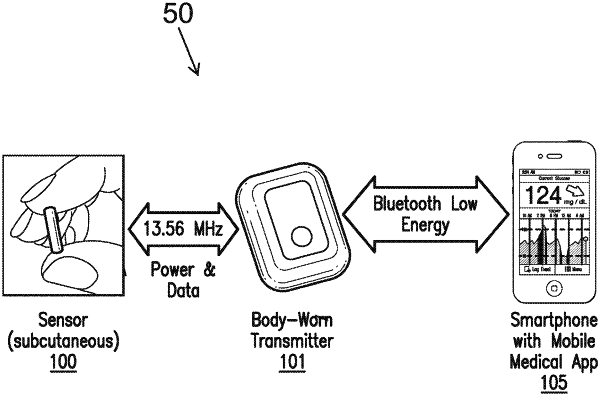| CPC A61B 5/1495 (2013.01) [A61B 5/0031 (2013.01); A61B 5/1459 (2013.01); A61B 5/14503 (2013.01); A61B 5/14532 (2013.01); A61B 5/150022 (2013.01); A61B 5/686 (2013.01); A61B 5/742 (2013.01); G01N 33/66 (2013.01); G01N 33/96 (2013.01); A61B 5/0004 (2013.01); A61B 5/0026 (2013.01); A61B 5/15142 (2013.01); A61B 2560/0223 (2013.01); A61B 2560/0252 (2013.01)] | 18 Claims |

|
1. An analyte monitoring method comprising:
using a light source of an analyte sensor of an analyte monitoring system to emit excitation light that interacts with indicator molecules of an analyte indicator of the analyte sensor;
using the indicator molecules of the analyte indicator with which the excitation light interacts to emit emission light;
using the analyte sensor to generate sensor data indicative of an amount or concentration of an analyte in proximity to the analyte indicator, wherein using the analyte sensor to generate the sensor data comprises using a photodetector of the analyte sensor to generate a measurement indicative of a level of the emission light emitted by the indicator molecules;
using a transceiver interface device of the analyte sensor to convey the sensor data;
using a sensor interface device of a transceiver of the analyte monitoring system to receive the sensor data conveyed by the analyte sensor;
using the transceiver to receive a first reference analyte measurement (RM1);
using a processor of the transceiver to determine that the RM1 is unexpected;
after determining that the RM1 is unexpected, using the transceiver to receive a second reference analyte measurement (RM2);
using the processor of the transceiver to use the sensor data to calculate a first sensor analyte measurement (SM1) without using the RM1 for calibration;
using the processor of the transceiver to use the sensor data to calculate a second sensor analyte measurement (SM2) with the RM1 used for calibration;
using the processor of the transceiver to determine that one or more of the RM1 and the RM2 are acceptable as calibration points, wherein determining that one or more of the RM1 and the RM2 are acceptable as calibration points comprises comparing the RM2 with the SM1 and comparing the RM2 with the SM2;
using the processor of the transceiver to accept one or more of the RM1 and the RM2 as calibration points; and
using the processor of the transceiver to calibrate the analyte sensor using at least one or more of the RM1 and the RM2 as calibration points.
|